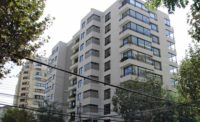The California Geological Survey in November released its final maps of the Hollywood and Sierra Madre fault lines, a measure that could have widespread impacts on development and construction in Los Angeles and its surrounding counties. The final maps create off-limits zones for new construction and could drive owners to retrofit existing buildings.
The state’s conclusion on the path of the Hollywood Fault is particularly bad news for the proposed 39-story Millennium Tower, designed to be the tallest building in Hollywood’s history. The California Geological Survey (CGS) says the site sits atop an active splay of the fault. However, developer Millennium Partners is undeterred: The firm said in a statement that it intends to continue pursuing the project, with further geological testing.
CEO Philip Aarons says Millennium can demonstrate from expert conclusions that there is no active fault line on the site. “We've said it before and we've said it again: Millennium Hollywood is steadfast in its commitment to building a safe project that conforms to the highest earthquake-resiliency standards," he says.
Other developers have been buying up land in Hollywood in the hope Los Angeles Mayor Eric Garcetti’s push to extend building-height limits in the area will make property values soar. The new map could change that.
Structural Focus Engineers, Gardena., Calif., said clients, such as Millennium, that are especially excited about a particular site are in for a long process if they want to prove the state wrong on its final fault map. “If there is a possibility that a site is compromised by a fault, then the very first step is to let the client know that it’s going to be a long process, and it’s probably going to be expensive,” says David Cocke, structural engineer at Structural Focus.
“You’re going to have to hire experts that specialize in finding traces, and it costs a lot to compile data and dig trenches. Also, you’re going to have to do enough to prove the state wrong,” he says. “In some cases, that money might be spent only to confirm the findings of the state—that nothing can be built on the site. All of that has to be done way before we do any calculations or in any way approach an initial design.”
Hollywood is in the midst of its biggest period of development and construction in decades, but no updated fault maps were available to help developers and engineers avoid active splays of the fault line. Critics and industry watchdogs have said this situation has allowed for carte blanche development in recent years and credited developers with “escaping seismic review” in several instances.
That’s not true, says Tim McCrink, mapping program coordinator for CGS. He cites the 1972 Alquist-Priolo mapping program, which created zones of investigation and put burdens on developers. “Los Angeles treated it like it was a law,” he says. "They required the Millennium Hollywood to do more testing, and they were forced to delay the project.”
Preliminary versions of the map, released earlier in 2014, noted a fault line running directly underneath BLVD 6200, a mixed-use building near the famed intersection of Hollywood Boulevard and Vine Street. At the time, California state geologist John Parrish told ENR the building would be in violation of state law if the final map made no revision.
In September, the CGS told ENR it was reviewing information received from BLVD 6200's owner. “However,” Parrish said, “CGS has not received any data or reports to date from the surrounding trench and CPT [cone penetrometer] investigations conducted by Group Delta [the building’s geotechnical consultant]. Therefore, no concluding interpretations have been made by CGS.”
Since then, CGS was convinced by contractors that BLVD 6200 did not sit atop the fault line. “They hired a consultant that did a lot of topographic transects and made an argument that the fault scarped slightly to the north of the property,” McCrink says. “That, along with some additional communication from the geotechnical engineer—which involved dipping of sediment beds to the south, between the BLVD 6200 site and another development site—gave us a reason to move the fault from its position on the preliminary map.”
Next, CGS will map the Santa Monica fault line on Los Angeles' west side as well as faults in the city's northeast area. Those mappings could further change the landscape of future construction projects in the megalopolis.


Post a comment to this article
Report Abusive Comment